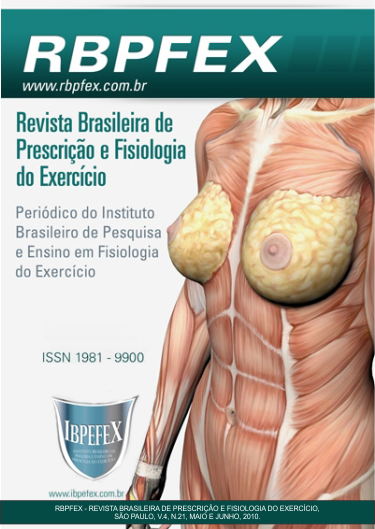Double product in carried through exercises of force in two different speeds
Abstract
Introduction: Although the current literature have dates showing that the blood rate pressure in resistance exercise is bigger than aerobic exercise, some questions need to be illuminated yet, as possible differences of blood rate pressurein resistance exercise made in different speeds. Goal: To compare the blood rate pressureon resistance exercise into 1010 and 4020 speed. Methodology: It is a descriptive research with 4 men (21.8 age). They accomplished tree sets of 30s with two minutes rest between sets in two machines for legs (leg 45º and knee extension), and two for arms (peck deck and Pulley). At first day the exercises were accomplished in 1010 speedand 48hs after in 4020 speed. Heart rate measurements and blood pressure were taken immediately after the 3rd set of each exercise. An sphygmomanometerand cardiac monitor were used. Results: was found a blood rate pressureof 25118.6 to 1010 speedsand 22569.5 to 4020 speeds. That systolic blood pressure was similar in both speeds (159.9 mmHg and 156.3mmHg to 1010 and 4020 respectively). In the other hands, the heart ratewas higher in 1010 (166.9 bpm) than 4020 (143.4 bpm). Conclusion: we ended that theblood rate pressurewas higher in the faster exerciseshowever, the decisive factor was the higher heart ratein the 1010 speeds.
References
-Balsamo, S.; Simão, R. Treinamento de Força para Osteoporose, Fibromialgia, Diabetes Tipo 2, Artrite Reumatóide e Envelhecimento. Phorte Editora São Paulo, 1º edição. 2005.
-Camara, L.C.; e colaboradores. Exercícios resistidos terapêuticos para indivíduos com doença arterial obstrutiva periférica: evidências para prescrição. J. Vasc. Bras., Porto Alegre, Vol. 6. Num. 3, sept. 2007.
-Feigenbaum, M.S.; Pollock, M.L. Prescription of resistance training for health and disease. Clinical Sciences Medicine & Science in Sports & Exercise. Vol. 31. Num. 1. 1999. p. 38-45.
-Kleiner, D.M.; Blessing, D.L.; Mitchell, J.W.; Davis, W.R. A description of the acute cardiovascular responses to isokinetic resistance at three different speeds. J Strength Cond Res. Num. 13. 1999. p. 360-366.
-Leite, T.C.; Farinatti, P.T.V. Estudo da freqüência cardíaca, pressão arterial e duplo produto em exercícios resistidos em diversos grupamentos musculares semelhantes. Revista Brasileira de Fisiologia do Exercício. Vol. 2. 2003.
-Mcardle, W.D.K.; Frank, I.K.;Victor, L. Fisiologia Humana -energia, nutrição e desempenho humano. 4ª ed. Editora Guanabara Koogan. Rio de Janeiro, 1998. p. 509.
-Polito, M.D.; Simão, R.; Nóbrega, A.C.L.; Farinatti, P.T.V. Pressão arterial, frequência cardíaca e duplo-produto em séries sucessivas do exercício de força com diferentes intervalos de recuperação. Revista Portuguesa de Ciências do Desporto. Vol. 4. Num. 3. 2000.p. 7–15.
-Pollock, M.L.; Franklin, B.A.; Balady, G.J.; Pin ̃A, B.L.; Chaitman, J.L.; Fleg, B.; Fletcher, M.; Limacher, I.L.; Stein, R.A.; Williams, M.; Bazzarre, T. Resistance Exercise in Individuals With and Without Cardiovascular Disease Benefits, Rationale, Safety, and Prescription An Advisory From the Committee on Exercise, Rehabilitation, and Prevention, Council on Clinical Cardiology, American Heart Association Position paper endorsed by the American College of Sports Medicine 2000
-Silva, H.T.L. Avaliação da segurança cardiovascular através do duplo produto em exercício de contra –resistência Monografia de Graduação do Curso de Educação Física, UFPB, João Pessoa: maio, 2006.
Authors who publish in this journal agree to the following terms:
- Authors retain the copyright and grant the journal the right of first publication, with work simultaneously licensed under the Creative Commons Attribution License BY-NC which allows the sharing of the work with acknowledgment of the authorship of the work and initial publication in this journal.
- Authors are authorized to enter into additional contracts separately for non-exclusive distribution of the version of the work published in this journal (eg, publishing in institutional repository or book chapter), with acknowledgment of authorship and initial publication in this journal.
- Authors are allowed and encouraged to post and distribute their work online (eg, in institutional repositories or on their personal page) at any point before or during the editorial process, as this can bring about productive change as well as increase impact and impact. citation of published work (See The Effect of Free Access).






